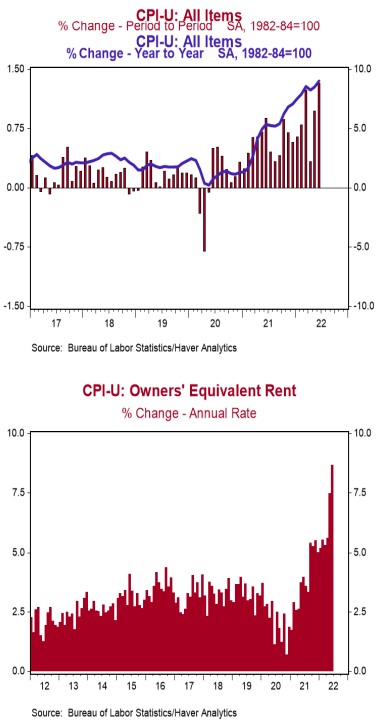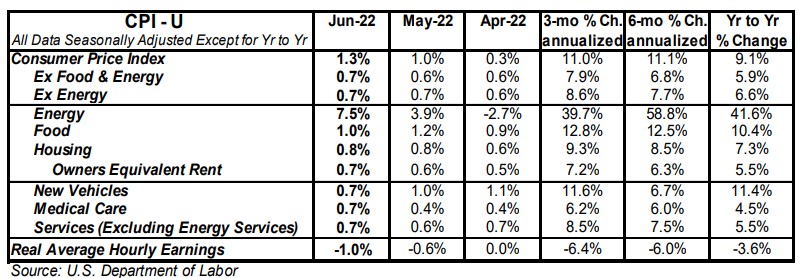- The Consumer Price Index (CPI) increased 1.3% in June, above the consensus expected +1.1%. The CPI is up 9.1% from a year ago.
- Energy prices increased 7.5% in June, while food prices increased 1.0%. The “core” CPI, which excludes food and energy, rose 0.7% in June, above the consensus expected +0.5%. Core prices are up 5.9% versus a year ago.
- Real average hourly earnings – the cash earnings of all workers, adjusted for inflation – declined 1.0% in June and are down 3.6% in the past year. Real average weekly earnings are down 4.4% in the past year.
Implications:
Inflation is high, sticky, and it is not slowing down. Consumer prices soared 1.3% in June, the largest monthly increase in more than a decade, pushing the year-ago comparison to a new post-COVID peak of 9.1%, the highest in more than four decades. Meanwhile, “core” prices rose 0.7% in June, and are up 5.9% from a year-ago. The details of today’s report show that the volatile energy and food prices led the overall index higher, rising 7.5% and 1.0%, respectively. The jump in energy prices came from an 11.2% increase in gasoline prices, while food prices at home have risen at least 1% for six consecutive months. Unfortunately, stripping out food and energy does little to improve the inflation picture. Housing rents (for both actual tenants and the rental value of owner-occupied homes) continued to accelerate in June, rising 0.7%. Notably, rental prices for actual tenants had the largest monthly increase since 1986. Rents have been a key driver for inflation in 2022, and should continue to do so in 2023-24 because they make up more than 30% of the overall CPI and still have a long way to go to catch up to home prices, which skyrocketed during COVID. But core inflation doesn’t stop there; nearly every core category had higher prices, including new and used autos (+0.7% and +1.6%, respectively), auto repair services (+2.0%), apparel (+0.8%), and medical care services (+0.7%). Some analysts may point out that the 12-month increase for core prices has moderated of late, but look for it to rebound in the months ahead as third quarter inflation softened temporarily in 2021, meaning readings in the realm of the 0.6% average seen year-to-date would push core inflation to near 7.0% on a 12-month basis as soon as September. Since February 2020 (pre-COVID), consumer prices are up at a 5.8% annual rate and core prices are up at a 4.3% rate. How did we get here? By forcing an economy to shutdown while simultaneously injecting an unprecedented amount of fiscal and monetary stimulus. The M2 measure of money supply is up over 41% since February 2020. Inflation has been – and always is – a monetary phenomenon. To get inflation back down to 2.0%, the Fed needs to focus less on hiking interest rates and more on getting the growth in the money supply under control.





